
Wanna have more fun? Of course you do. Bodysurf more. Photo: Drew Farwell
There are few things more fun than a good womp session. Bodysurfing is a vastly underrated method of having fun, generally overshadowed by plain old surfing with a surfboard. Waves, however, are not always perfect for surfing, so if you’re at all proficient at bodysurfing, it means you’ve got another option to recharge the fun reserves. As someone once said, you can’t trust a person who can surf but can’t bodysurf. And you know what makes bodysurfing way more fun? A decent set of fins. That’s why, in our perpetual quest to fill the world with people having more fun, we’ve stitched together a list of the best fins for bodysurfing. Choose carefully, and go enjoy the womp!
The Best Bodysurfing Fins
DaFin Pro Classic Swim Fins ($73)
Churchill Makapuu Floating Fins ($50-60)
Mike Stewart Viper Swim Fins ($81)
Hydro Tech 2 Surf Swimfins ($100)
Voit Duck Feet Fins ($70)
Viper V5 Bodysurfing Fins ($99)
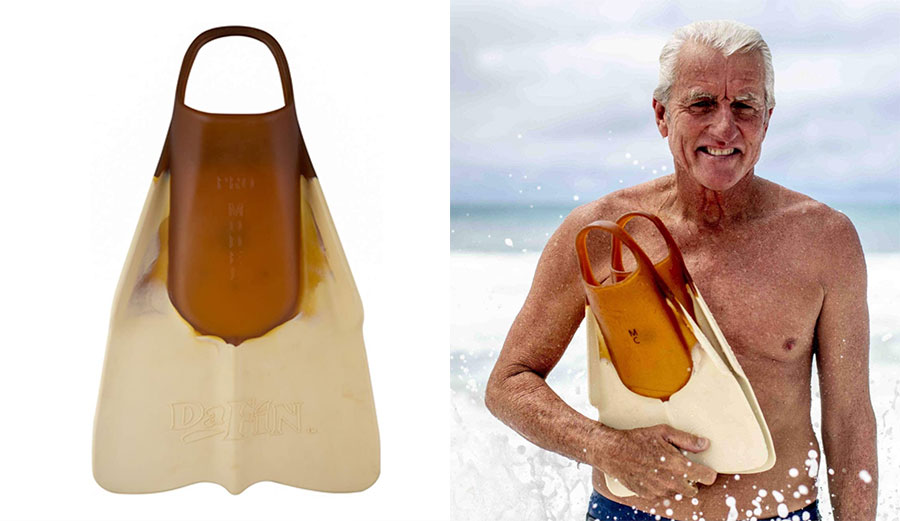
DaFin Pro Classic Swim Fins ($73)
Pros: Comfort, superior design
Cons: Not much, to be honest!
If you’re looking for the most comfortable and functional fins on the market, these are your guys. In a product category marked by bloody heels, The Inertia staff can attest that these fins leave fewer gaping, bloody holes than their peers. Furthermore, they’ve got the added credibility of being the fin of choice for lifeguard programs across the U.S., and legendary bodysurfer Mark Cunningham.
Cunningham is a cornerstone of the North Shore community with 29 years of service as a lifeguard on the North Shore of Oahu under his belt, and he’s widely lauded as the best bodysurfer in the world with 16 North Shore Bodysurfing Championship titles, the first in 1974, and the last at the age of 44, in the year 2000. He’s got his own signature model (pictured above), which features a 10-percent softer foot pocket than other DaFin models, but really any Dafin Pro Classic model should do the trick for ya. As of publishing, they’re the official fin of the North Shore Lifeguards, and they’re the best bodysurfing fins on the market. Full stop.
CHECK PRICE ON Cleanline Surf CHECK PRICE ON AMAZON Mark Cunningham Signature Model
Churchill Makapuu Floating Fins ($50-60)
Pros: Classic design, tried and tested
Cons: Asymmetrical shape isn’t for everybody
We couldn’t have a list of bodysurfing fins without Churchills. If you have spent any time at all in the wave riding scene, then it’s almost impossible for you not to have seen a set of these, and it’s likely they were blue and yellow. They’re standard equipment in any well-rounded quiver, and they’ve been in the game since 1936. The tail was originally designed to resemble a dolphin’s tail. The U.S. Navy used them for a stint, and in 1971, when bodyboarding gained some serious traction, they became the world’s best-selling fins, and they’ve held onto that title ever since. All those years and all those people can’t be wrong, can they?
CHECK PRICE ON AMAZON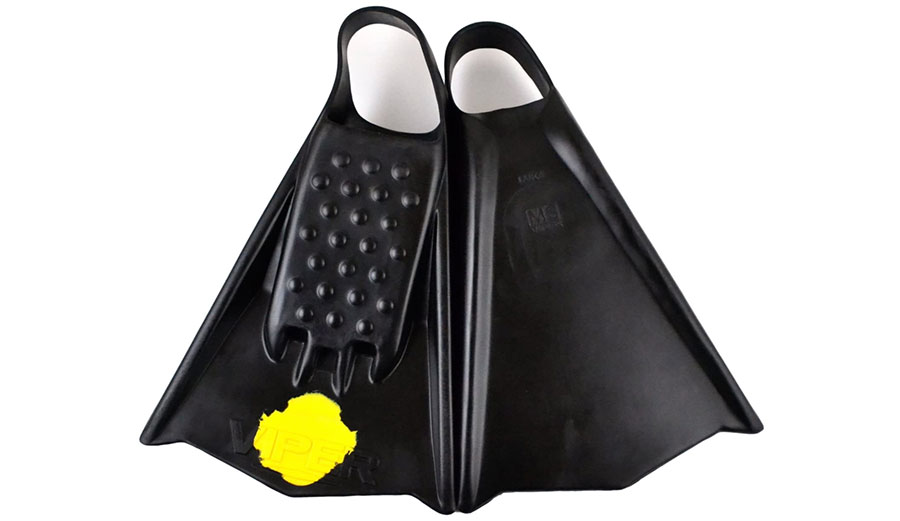
Mike Stewart Viper Swim Fins ($81)
Pros: Shorter blade means quick acceleration
Cons: The rubber can turn soft skin into a blister farm
Mike Stewart is a man who knows all about riding waves. Sure, he’s won most of his awards on a bodyboard, but the man definitely does not need one to ride them. See, for example, his Teahupoo antics. So when he lends his name to a swim fin, you can bet it’s top-shelf. These Vipers have a wider, shorter blade for quick acceleration, which is arguably the most important function a bodysurfing fin has. The beveled sidewalls greatly improve control, which is a good thing if you’re not trying to fill all your orifices with sand. Actually, that’s probably going to happen either way, but you get the gist.
The yellow dot version is the stiffer model, so it’s best to go for one of the other colors if you prefer a bit more flex on the blade.
CHECK PRICE ON AMAZON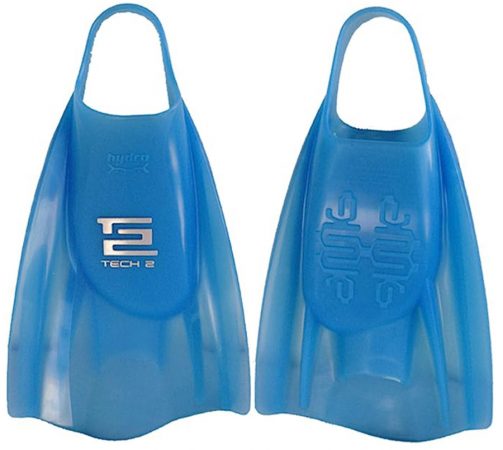
Hydro Tech Surf 2 Swimfins ($99)
Pros: Lightweight and responsive
Cons: Do not float, can feel flimsy compared to the others.
These fins are made from soft silicone that give incredible comfort, especially for those sensitive to rubber. They move fast and are responsive, but be careful, they don’t float, which might not be the best choice in heavy surf. That said, you can always snag a fin leash to keep them secure!
The fins are also a bit more flexible than other, natural rubber fins on this list. Where these fins shine is the comfort – silicone simply won’t rub a hole in your heels in the same way that rubber will. Silicone also lasts longer from a durability point of view as rubber fins tend to degrade and crack after a while (pro-tip, don’t store your fins outside, and rinse them after each use).
CHECK PRICE ON AMAZON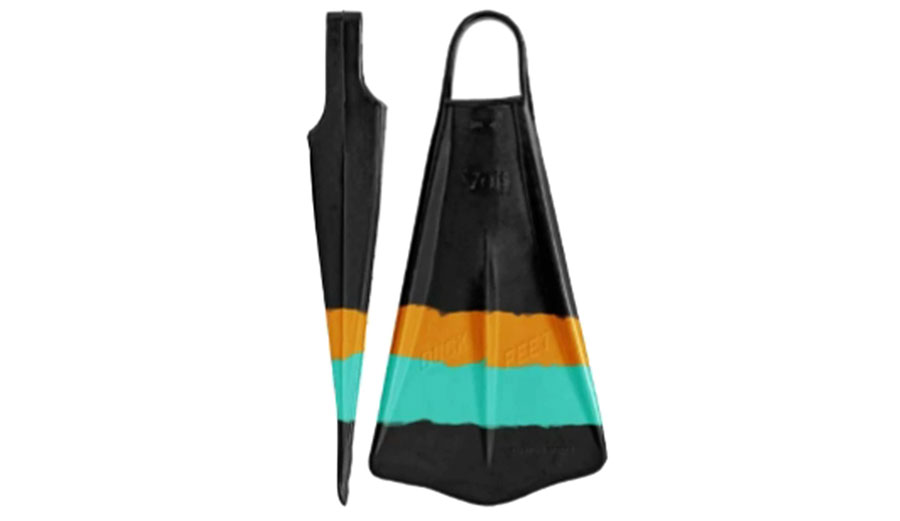
Voit Duck Feet Fins ($70)
Pros: Nice and stiff in some people’s eyes
Cons: Too stiff in some people’s eyes
Duck Feets (Duck Foot?) are up there in the realm of the classic fin, just like Churchill. Made with dual-density rubber and a soft foot pocket with a stiffer blade, they’re designed specifically for maximum propulsion with minimal effort. These, along with Churchills, are a good entry point to someone who’s just looking to cruise around on a wave instead of winning championships… which is most of us.
CHECK PRICE ON AMAZON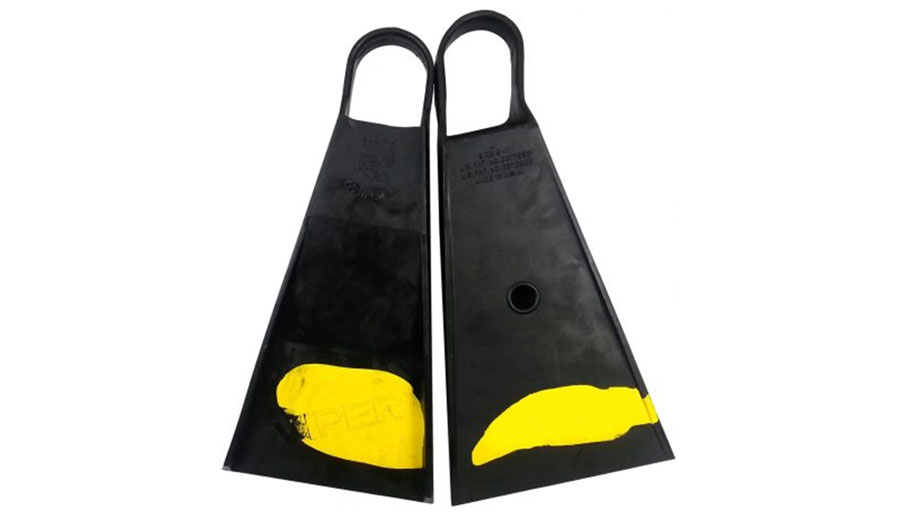
Viper V5 Bodysurfing Fins ($99)
Pros: Fast and powerful
Cons: Prone to rubbing skin off your heel
These are classics. They’re tried and true, powerful fins. However, from personal experience we must share that they’ll happily carve a bloody hole into your heel, which can often be a function of buying fins that are slightly too loose. These are very hard, which is great for power and speed, but can create issues when it comes to comfort. They’ve got a 5″ long blade, and since they’re a classic, they’re worth checking out. Just make sure they fit securely.
CHECK PRICE ON AMAZONComparison Table
| Model | Price | Features |
| DaFin Pro Classic | $73 | Legendary Design |
| Mike Stewart Viper | $81 | Wide blade |
| Churchill Makapuu | $50-$60 | All-time Classic |
| Voit Duck Feet | $70 | Stiff |
| Viper V5 | $99 | Firm |
| Hydro Tech Surf 2 | $99 | Silicone |
Buying The Right Bodysurfing Fin For You
There are a variety of different factors that go into bodysurfing fins that will help you determine which one is right for you. Those are:
Fin Length
The longer the fin, the more propulsion (or power) you have, given all the other factors were constant. But to generate more power, you’ll need to work harder, meaning you’ll get tired faster, all things considered. But a shorter fin is more maneuverable and easier to move around in the water; meaning a bit more precise control.
Fin Width
Wider fins can provide more propulsion, yet can provide less control and stability when in motion. Some fins have an asymmetrical shape that can help with control, but can be a bit more of a learning curve to get them to perform just how you intend.
Blade Stiffness
The stiffer the blade, the more power and propulsion but a softer blade will offer more control. It’s also a question of strength and how fast you want to get up to speed. Large forceful strokes might prefer a stiffer blade, while faster strokes in faster waves might appreciate a softer blade.
Fin Material
Any good fin is made from either rubber or silicone. Rubber can be stronger and more durable, but are also heavy and prone to making blisters. Silicone fins are more lightweight, flexible, and generally more comfortable than rubber; however can suffer in the performance department with people who know how to push it.
Drainage
As hard as we may try to emulate having fins, they are still but false appendages that will inevitably fill with water as we move our bodies through the medium. Having the water drain out efficiently will help with your own efficiency. Be sure the holes and channels work the best with your foot and swimming style to ensure the water passes through ideally without a necessary holdup as it passes through the fin.
Price
You’ll find something good here in the $50-100 range. If anything retails for less then make sure it’s not just some cheap plastic unit that will break apart after heavy use. Surely there will be sales that could get one of the listed fins below that threshold, and if that’s so, try to jump on that deal. But if you’re just getting the “sporting goods aisle” model of fins and trying to use it out in the surf, be prepared for disappointment and shame for bringing those things where they have no business showing themselves. Like any cheap product, it usually ends up costing more in the long run when you have to replace them.
Need some inspiration?
To see what’s possible in bodysurfing, check out Come Hell or High Water to see what some of the best out there are doing. It’ll get you fired up for a womp thanks to Keith Malloy and the rest of the Torpedo People.
Editor’s Note: For more gear reviews and features on The Inertia, click here.





